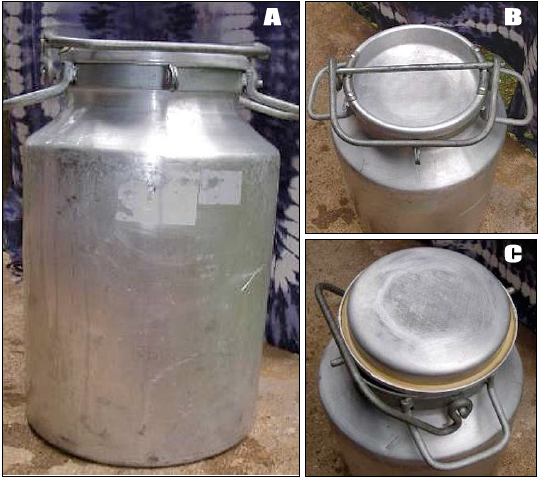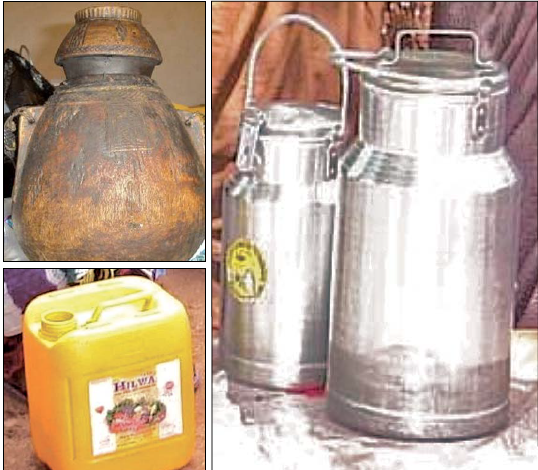As we have seen customers prefer to buy clean, healthy milk with an attractive sweet taste. This is the product with the highest amount of customers. If customers cannot get this quality from the informal milk market they will buy any alternative including the very expensive long life milk.

NOTE: inside rubber seal in lid to make sure it does not spill
The informal market can produce good quality milk by ensuring the following actions become a habit:
Handling at milking level
- Maintain clean and healthy milking animals – milk unhealthy animals last.
- Use appropriate sterilised containers for milking.
- People milking animals must be healthy and maintain good personal hygiene and wear clean clothes when milking.
- After milking, the milk must be covered to avoid contamination.
- Transport containers must be very clean and be sterilised each day before using.
- The milk gets boiled or pasteurised before it is filled into transport containers and quickly cooled, so that it can reach the market in good condition if long transport hours are predicted.
Handling at bulking/storage level
The agent must make very sure that bulking containers are very clean, and sterilised before taken into use.
- Clean the bulking container very well.
- Pour some boiling water into the bulking container and swish it around till all corners have been sterilised. Pour the water out.
- Put boiled milk in separate containers and raw milk in separate containers.
- Do NOT mix boiled and unboiled milk or evening and morning milk.
- Close the container with a clean sterilised lid.
- Boiled milk should be cooled in the storage container.
- All milk waiting for transportation should be kept as cold as possible – under shade, in the wind, etc.
Handling at transportation level
Presently all milk transporting vehicles in dry areas tie milk containers to the top and side of their lorries and transports them in full sun. This is not the best as the milk will heat up and start the spoilage process. However examples have been observed of bulking agents sending their milk container in a wet bag. This would help cool the milk during transportation.
Transport options are usually shared with transport of people and other goods, so normally people wait untill the vehicle is full. Long waiting time is bad for the milk.Try to discuss with the transporters how the milk can be shaded or protected and reach the market without delay. The following are some possibilities of improving the milk transportation conditions:
- Cover the milk cans with a canvas for shade, with free air movement underneath.
- Send the milk cans in a wet bag to help cool the milk on the way.
- If there is a lot of milk in an area the transporter may be willing to make an early milk transport without waiting for passengers – try negotiations with transporter, i.e. use of dedicated means of transport.
Handling at distribution/selling level
After reaching the market, milk is often again redistributed to smaller containers and delivered to separate customers. This is a new source of possible contamination. The following precautions are recommended:
- Wash milk containers very well, till no traces of old milk is seen.
- Sterilise containers with boiling water, pour the water again. Clean and sterilise all tools including funnels, etc.
- Decant the milk into clean containers.
- Close the milk containers with a clean sterilised top/cover. Do NOT transport milk uncovered, as it will attract flies and other contamination.
Handling at the market place
Customers are very particular about the premises they want to buy milk from. Business will be comparatively poor on a dusty street, and comparatively lively in a well defined clean shaded market place, with access to clean water and staffed by people in clean (light coloured aprons) clothes. Customers must also be able to enter the market place without getting soiled, so proper access is important. Public health issues can be taken care of in clean premises, but not in dusty streets. Well organised milk sellers will be able to find support for the construction of clean market shelters.
Economics of improved milk cans
In November 2007, Long term cost of plastic jerricans in Garissa was compared to Perdini sealed aluminum milk cans with a lifespan of at least 5 years:

Thus whereas the price of buying a new aluminium milk can is fairly high, it is a one time investment. The same can last for at least 5 years, whereas a (cheap) plastic jerrican will have to be replaced every two weeks or so. Over a 5 year period the aluminium can saves the buyer Kshs 16,000 (2007 prices).
Above table clearly shows the financial benefits of purely using metal milk cans instead of plastic jerricans. Perdini milk cans are

traditional containers and the jerricans. They can be disinfected after washing by
dipping in boiling water, and become virtually germ free – which means longer shelf
life for the milk as there is no contamination from cans
Other milk cans
The ordinary Kaluworks aluminum milk cans of 2, 5 and 9 L are good for delivering milk from transport site to customers. They are cheap compared to the Perdinini cans and can last a long time if properly cared for.
In high potential areas heavier duty milk cans are used as they need to be able to withstand punishment in a different type of transport – pure milk transporting vehicles.